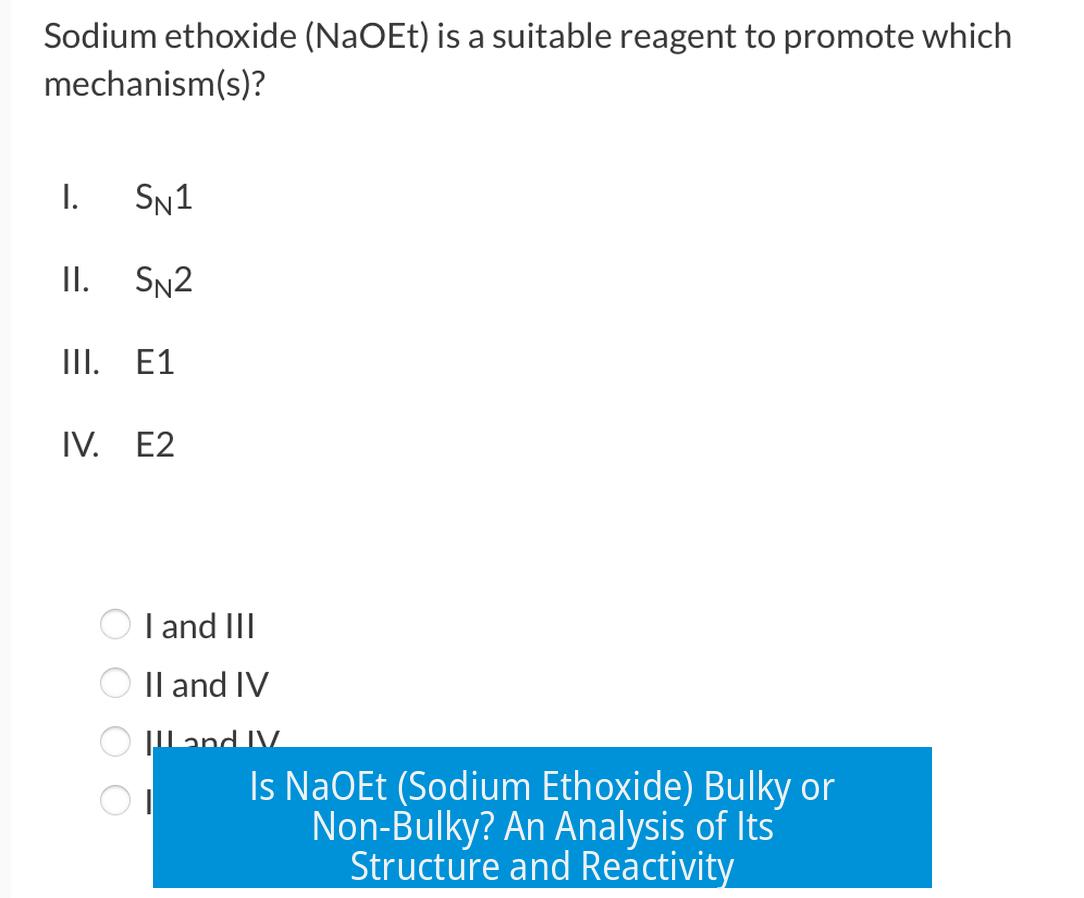Is NaOEt (Sodium Ethoxide) Bulky or Non-Bulky?
Sodium ethoxide (NaOEt) is considered a non-bulky base and nucleophile.
This conclusion follows from its chemical structure, reactivity patterns, and comparison to other alkoxides. Here, the term “bulky” refers to the steric hindrance created by the size and shape of substituents attached to the reactive site. Sodium ethoxide contains an ethyl group—a relatively small alkyl substituent—that does not impose significant steric hindrance around the oxygen anion. Consequently, NaOEt behaves as a moderately small and accessible nucleophile/base in organic reactions.
Chemical Identity and Molecular Structure
Sodium ethoxide is the ionic compound with the formula CH3CH2ONa, commonly denoted as NaOEt. It consists of a sodium cation (Na+) paired with an ethoxide anion (CH3CH2O−).
X-ray crystallography reveals a layered crystal structure made of alternating Na+ and O− centers. The ethyl groups attached to the oxygen cover the top and bottom of these ionic layers. The ethyl groups pack back-to-back, forming a lamellar arrangement. This packing style indicates minimal steric obstruction adjacent to the oxygen anion.
Significance of the Ethyl Group Size
- The ethyl group (–CH2CH3) is small and flexible compared to larger alkyl substituents such as tert-butyl (t-Bu).
- Because of this small size, the oxygen’s lone pairs and negative charge remain relatively accessible.
- This accessibility facilitates NaOEt’s role as an effective nucleophile and base.
Bulky vs. Non-Bulky Alkoxides: Concept and Importance
In organic chemistry, bulkiness of an alkoxide influences its behavior as a base or nucleophile. Bulky alkoxides have large alkyl groups that block approach to the reactive center. They often favor elimination over substitution or deprotonation due to steric hindrance.
In contrast, non-bulky alkoxides have smaller substituents, permitting easier access to the reactive site. These bases favor substitution and deprotonation reactions.
Examples
| Alkoxide | Alkyl Group Size | Bulkiness | Common Applications |
|---|---|---|---|
| Sodium ethoxide (NaOEt) | Ethyl (C2H5) | Non-bulky | Claisen condensation, malonic ester synthesis, nucleophilic substitutions |
| Sodium tert-butoxide (NaOtBu) | tert-Butyl (C(CH3)3) | Bulky | Elimination reactions, sterically hindered bases |
Reactivity Patterns Indicate Non-Bulky Nature
Sodium ethoxide is prominent in organic synthesis where moderate nucleophilicity and basicity are required. It participates efficiently in the following:
- Claisen Condensation: Deprotonation of α-protons adjacent to esters requires a base small enough to access the substrate’s reactive site.
- Malonic Ester Synthesis: Similarly, the base deprotonates active methylene groups.
- Transesterification Reactions: Here, sodium ethoxide acts as a nucleophile displacing substituents on esters.
These roles demand minimal steric hindrance. Bulky bases tend to disfavor nucleophilic substitution due to spatial constraints. Therefore, NaOEt’s success in these reactions supports its classification as a non-bulky base.
Comparison With Bulky Alkoxides
Larger alkoxides, such as sodium tert-butoxide, hinder nucleophilic attack on sterically crowded centers. They mainly promote elimination reactions instead.
Sodium ethoxide’s moderate size enables it to balance nucleophilicity and basicity effectively. Hence, it finds broad use in functional group transformations requiring nucleophilic attack.
Role as a Precursor in Alkoxide Chemistry
Sodium ethoxide serves as a starting point for synthesizing many other alkoxides via salt metathesis reactions. This synthetic utility underlines its relatively small size and straightforward accessibility.
- The ability to generate other, often bulkier, alkoxides from NaOEt demonstrates that it itself is less hindered.
- This feature facilitates its widespread application in organosodium reagent chemistry.
Summary of Factors Supporting Non-Bulky Classification
- Chemical structure: Contains a small ethyl group attached to oxygen, indicating moderate sterics.
- X-ray crystallography: Shows layered ionic structure with ethyl groups spaced apart, reducing steric hindrance.
- Reactivity in key reactions: Efficiently deprotonates and performs nucleophilic substitution where bulky bases fail.
- Comparison to bulky analogues: Smaller than tert-butoxide, showing less steric hindrance.
- Precursor role: Used to prepare bulkier alkoxides, implying it is less hindered itself.
Key Takeaways about Sodium Ethoxide (NaOEt) Bulkiness
- Sodium ethoxide contains an ethyl (C2H5) group, smaller than bulky alkyl substituents.
- Its crystal structure features ionic layers with minimal obstruction around reactive centers.
- NaOEt effectively participates in Claisen condensation and malonic ester synthesis, which require non-bulky bases.
- Sodium ethoxide is a common precursor for synthesizing other alkoxides, underscoring its accessibility.
- All available evidence consistently classifies NaOEt as a non-bulky base and nucleophile.





Leave a Comment